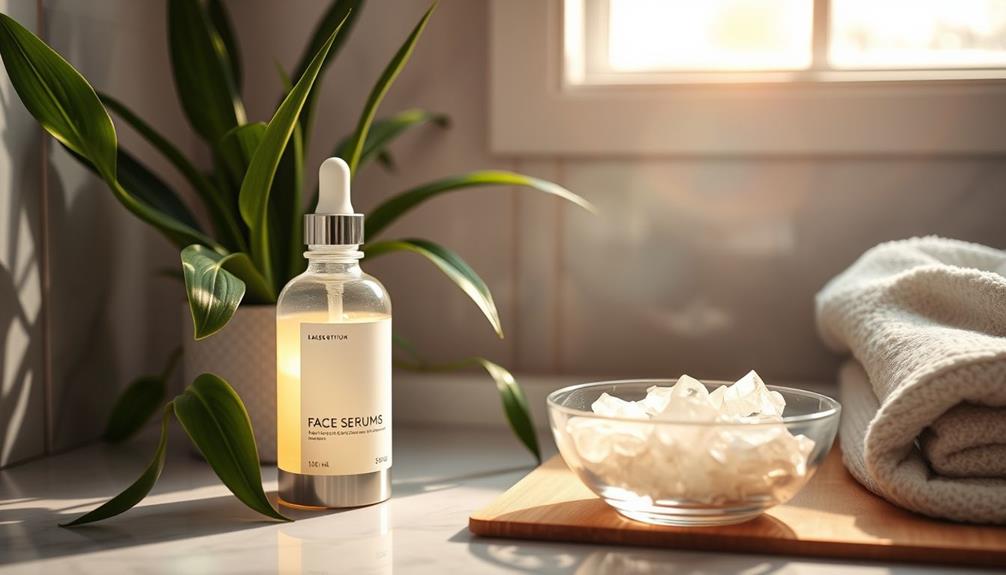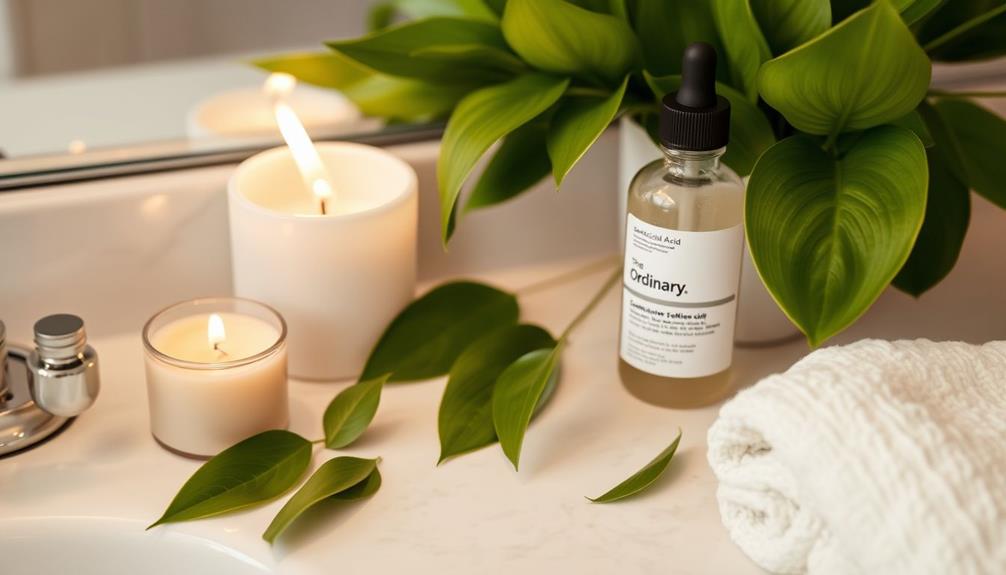Glycolic acid is the perfect ingredient to achieve a radiant complexion. Made from sugar cane, it effectively exfoliates by removing dead skin cells and encouraging cell turnover. This results in smoother skin and a glowing complexion. Glycolic acid also helps reduce dark spots and boosts the performance of other skincare products. Start with a low concentration and apply it at night, always remember to use sunscreen afterwards. Whether you have oily, dry, or normal skin, glycolic acid can meet your skincare needs. Interested in adding it to your routine? There’s more to learn about this amazing ingredient!
Key Takeaways
- Glycolic acid promotes cell turnover, effectively exfoliating dead skin cells for a smoother and brighter complexion.
- Regular use of glycolic acid reduces dark spots and hyperpigmentation, enhancing overall skin clarity and tone.
- It encourages collagen production, which helps maintain skin elasticity and minimizes the appearance of fine lines.
- Suitable for various skin types, glycolic acid can improve texture for oily, acne-prone, and normal skin.
Understanding Glycolic Acid
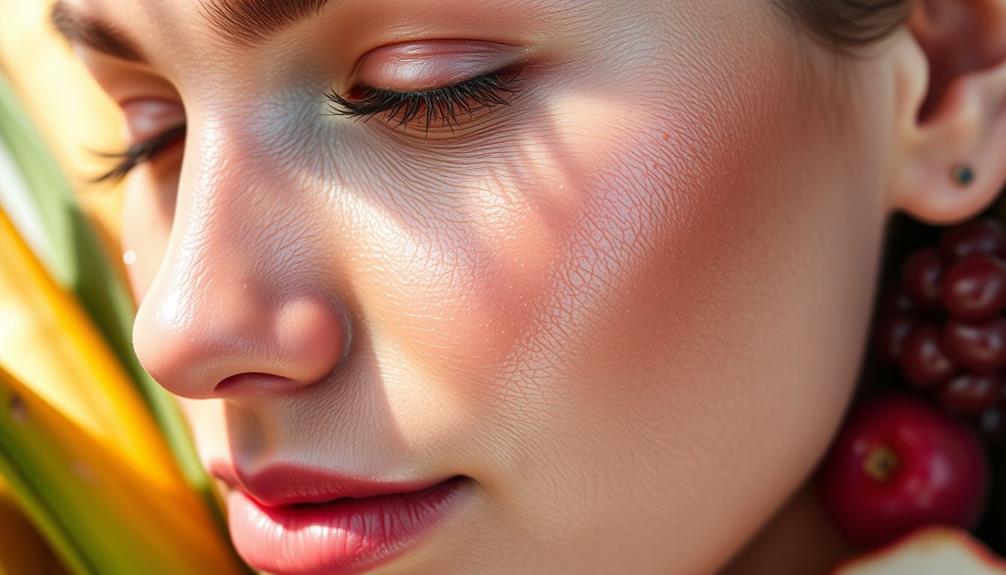
Glycolic acid, derived from sugar cane, is a powerful alpha hydroxy acid (AHA) that quickly penetrates your skin to deliver impressive exfoliating benefits. Its small molecular size allows it to effectively break down the bonds between dead skin cells, promoting cell turnover.
This process not only helps in exfoliating your skin but also enhances your skin texture, making it smoother and brighter. Additionally, incorporating essential oils for skin health can further support your skincare routine by providing nourishment and antimicrobial properties.
Glycolic acid is suitable for most skin types, particularly oily and acne-prone skin, as it can help reduce fine lines and improve overall skin appearance. However, if you have sensitive skin, you should use it with caution. Its potent exfoliating properties can lead to irritation or redness if overused.
In addition to its exfoliating benefits, glycolic acid encourages collagen production, which plays an essential role in maintaining skin elasticity and firmness.
Benefits of Glycolic Acid

Glycolic acid offers impressive benefits for your skin, starting with its powerful exfoliation and renewal properties.
You'll notice a brighter, more even complexion as it tackles dark spots and promotes skin clarity.
Its ability to enhance the effectiveness of your other skincare products makes it a must-have in your routine.
Additionally, incorporating essential oils for skin benefits can complement glycolic acid's effects, providing a holistic approach to skin health.
Exfoliation and Skin Renewal
Exfoliating with glycolic acid helps dissolve the bonds between dead skin cells, revealing a brighter and more radiant complexion underneath. This powerful Alpha Hydroxy Acid (AHA) not only enhances exfoliation but also promotes skin renewal by boosting cell turnover. As you incorporate glycolic acid into your routine, you'll notice smoother skin texture and a reduction in dark spots and signs of aging.
Here's a quick overview of the benefits of glycolic acid:
| Benefit | Description | Result |
|---|---|---|
| Exfoliation | Dissolves dead skin cells | Brighter complexion |
| Skin Renewal | Increases cell turnover | Smoother, even skin tone |
| Dark Spot Reduction | Diminishes hyperpigmentation | Reduced appearance of fine lines |
Regular use of glycolic acid allows your skin to absorb other skincare products more effectively, enhancing their results. Say goodbye to dull, uneven skin and hello to a rejuvenated appearance. With consistent application, you'll be well on your way to achieving that fresh, youthful glow!
Brightening and Even Tone
Achieving a brighter and more even skin tone becomes easy with the consistent use of glycolic acid, thanks to its powerful exfoliating and skin-renewing properties. This incredible ingredient works effectively to even out skin tone by sloughing off dead skin cells, which helps in reducing the appearance of dark spots and hyperpigmentation.
With regular application, glycolic acid enhances cell turnover, leading to improved skin clarity and a more radiant complexion. Incorporating practices from self-exploration through body awareness can also enhance your overall self-care routine, promoting a holistic approach to beauty.
Its small molecular size allows glycolic to penetrate deeper into the skin, effectively targeting uneven skin texture. By stimulating collagen production, it not only helps reduce the appearance of fine lines but also contributes to a firmer and more youthful look.
This dual action enhances overall skin brightness, making your complexion glow. Incorporating glycolic acid into your skincare routine can greatly improve your skin texture and tone.
Whether you're dealing with age spots or simply want a more luminous look, glycolic acid is an essential ingredient for achieving that brighter face you desire. Embrace the benefits of glycolic acid, and watch your skin transform.
Recommended Usage Guidelines

To get the most out of glycolic acid, start by using products containing it 1-2 times a week and increase the frequency as your skin adjusts. This gradual approach helps your skin tolerate the exfoliating effect without overwhelming it. Ideally, apply glycolic acid products at night for better absorption and to minimize sun sensitivity.
For added skin benefits, consider incorporating juices rich in antioxidants, like blueberry juice, which can support overall skin health.
Always pay attention to how your skin reacts. If you have sensitive or very dry skin, consider patch testing before full application. This way, you can confirm your skin won't react negatively.
When choosing products, carefully read the product labels to identify the concentration of glycolic acid and other ingredients.
Avoid using glycolic acid alongside other potent actives like retinol or salicylic acid in the same routine, as this can lead to irritation.
After applying glycolic acid, make sure to follow up with sunscreen during the day, since it can increase your skin's sensitivity to UV rays.
Skin Type Compatibility

Understanding how glycolic acid interacts with different skin types is key to maximizing its benefits while minimizing any potential irritation.
When considering skin type compatibility, you should know that glycolic acid is particularly effective for oily and acne-prone skin. It helps reduce excess oil production and unclogs pores, giving you a clearer complexion.
Additionally, maintaining a consistent skincare routine is essential for all skin types, as it fosters an environment where active ingredients can work effectively.
If you have dry or sensitive skin, it's important to proceed with caution. Start with lower concentrations and always perform patch testing to see how your skin feels before fully incorporating it into your routine understanding a cat's body language.
Here are some essential tips for using glycolic acid based on your skin type:
- Oily and Acne-Prone Skin: Opt for higher concentrations (up to 20%) for maximum effect.
- Dry and Sensitive Skin: Stick to lower concentrations (around 5%) to avoid irritation.
- Normal Skin: You can enjoy regular use for enhanced texture and radiance.
- Very Sensitive Skin or Rosacea: It's best to avoid glycolic acid altogether; consider gentler alternatives.
Choose wisely, and your skin will thank you.
Mixing Glycolic Acid With Other Ingredients

When mixing glycolic acid with other ingredients, you need to be mindful of compatibility.
Some combinations can enhance your skincare routine, while others might lead to irritation or reduced effectiveness.
For instance, incorporating anti-inflammatory foods in your diet can complement your skincare efforts by reducing skin inflammation.
Let's explore which ingredients work well with glycolic acid and which ones you should avoid.
Compatible Ingredients for Glycolic
Glycolic acid works best when paired with compatible ingredients that enhance its benefits and minimize potential irritation. By strategically mixing glycolic acid with the right elements, you can amplify its exfoliation powers while maintaining skin moisture.
Here are some compatible ingredients to take into account:
- Azelaic Acid: Targets blemishes and uneven skin tone, improving absorption of glycolic acid.
- Retinol: Use them on alternating nights to treat acne and brown scars without overwhelming your skin.
- Hyaluronic Acid: This hydrating ingredient helps counteract dryness from glycolic exfoliation, keeping your skin moisturized.
- Peptides: They work well with glycolic acid to promote skin repair and boost collagen production.
While combining these ingredients can yield great results, you should avoid mixing glycolic acid with salicylic acid or niacinamide, as these combinations may lead to irritation or reduced effectiveness.
Ingredients to Avoid
Certain ingredients should be avoided when using glycolic acid to prevent irritation and maintain skin health.
Mixing glycolic acid with salicylic acid can heighten the risk of dryness and irritation due to their combined exfoliating effects. Similarly, combining glycolic acid with lactic acid may compromise your skin barrier, leading to increased sensitivity and redness.
Layering niacinamide with glycolic acid isn't recommended. The higher pH of niacinamide can hinder the effectiveness of glycolic acid, reducing its benefits.
When it comes to retinol, using it alongside glycolic acid requires caution; consider alternating their use to minimize potential dryness and irritation.
Lastly, steer clear of combining glycolic acid with physical exfoliants. This can lead to over-exfoliation, which not only irritates your skin but also damages the skin barrier.
To enjoy the brightening benefits of glycolic acid while keeping irritation at bay, it's essential to choose your skincare ingredients wisely. By avoiding these combinations, you can maintain healthier skin and achieve the radiant glow you desire.
Optimal Application Timing
Apply glycolic acid at night to maximize its absorption and minimize any sun sensitivity, while reserving morning use for other actives like Vitamin C. This application timing is essential for achieving the best results in your skin care routine.
Here are some important considerations when mixing glycolic acid with other active ingredients:
- Avoid salicylic acid or lactic acid: Using these together can cause irritation and compromise your skin barrier.
- Skip niacinamide: The differing pH levels can reduce glycolic acid's effectiveness.
- Alternate retinol nights: Use retinol on separate nights to prevent dryness and irritation.
- Combine with hydrating agents: Pairing glycolic acid with hyaluronic acid enhances moisture retention, but don't apply them simultaneously to maintain glycolic acid's potency.
Precautions and Side Effects
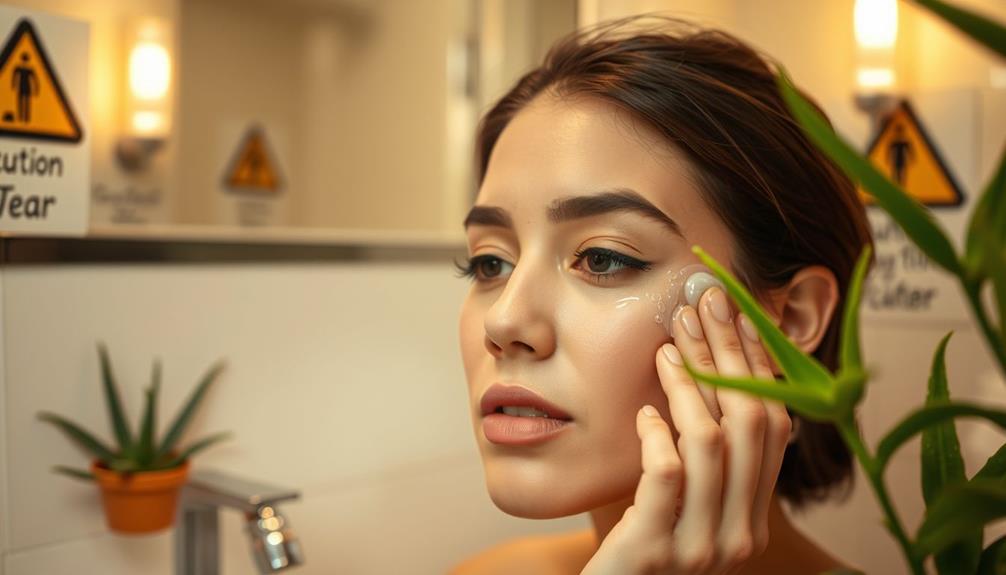
Using glycolic acid can lead to skin irritation, redness, and peeling, especially if you have sensitive skin or opt for higher concentrations.
To minimize side effects, start with a low concentration and use it just 1-2 times a week. Gradually increasing your usage allows your skin to acclimate, reducing the risk of adverse reactions.
It's essential to conduct patch testing before applying glycolic acid over your entire face. This simple step helps you identify any potential allergic reactions or heightened skin sensitivity. If you notice any irritation, it's best to stop using the product and consult a dermatologist.
Overusing glycolic acid can compromise your skin barrier, making your skin more vulnerable to external irritants and exacerbating conditions like eczema or rosacea.
Additionally, when using glycolic acid, always apply sunscreen during the day. This ingredient increases your skin's sensitivity to sunlight, raising the risk of sunburn.
Recommended Products
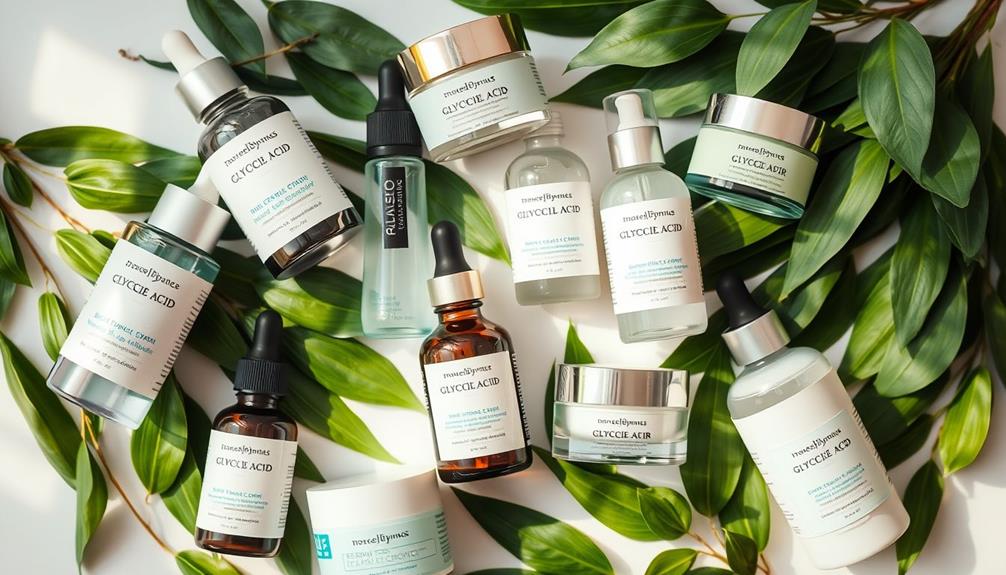
Wondering which glycolic acid products can help brighten your skin? Here are some top recommendations that deliver effective results. Incorporating these skincare products into your routine can enhance exfoliation, improve skin texture, and help reduce the appearance of acne scars.
- SkinCeuticals Glycolic 10 Renew Overnight: This lightweight overnight cream features 10% glycolic acid for gentle exfoliation and improved brightness.
- L'Oréal Paris Revitalift Triple Power 10% Pure Glycolic Acid Serum: An affordable option, this serum combines hydration from aloe juice with a potent 10% glycolic acid concentration.
- Drunk Elephant TLC Framboos Glycolic Night Serum: For a luxurious treatment, this serum blends AHA and BHA to promote cell renewal and even out skin tone.
- Naturium Glycolic Acid Resurfacing Solution 8%: Priced at $20, this gentle formula supports skin barrier function while enhancing radiance.
Choose any of these glycolic acid products to enjoy clearer, brighter skin!
Glycolic Acid for Specific Concerns
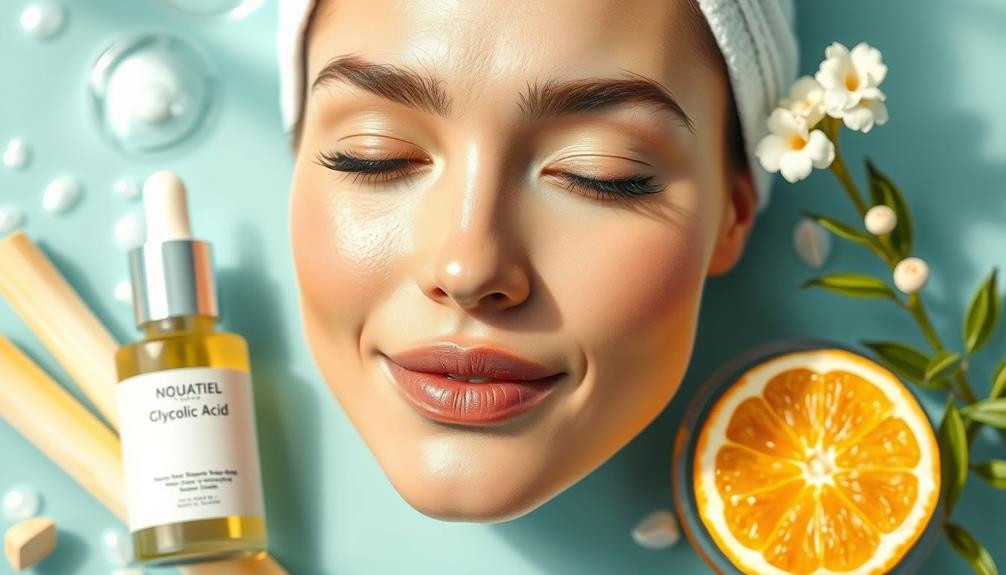
Glycolic acid addresses specific skin concerns like hyperpigmentation, fine lines, and acne, making it a versatile addition to your skincare routine.
When you incorporate glycolic acid, you help exfoliate dead skin cells, promoting cell turnover that reveals brighter skin. This powerful ingredient effectively fades hyperpigmentation and dark spots, giving your complexion a more even tone.
For those looking to reduce the appearance of fine lines and wrinkles, glycolic acid stimulates collagen production, contributing to a youthful and plump skin texture. Its small molecular size allows deeper penetration into the skin, so you'll notice quicker results compared to other AHAs.
If you're dealing with oily or acne-prone skin, glycolic acid is your ally. It works to unclog pores and regulate oil production, which helps prevent breakouts and keeps your skin looking fresh.
Regular use of glycolic acid can also enhance the absorption of other skincare products, maximizing their effectiveness in targeting your specific concerns. By adding glycolic acid to your routine, you're taking a proactive step towards achieving clearer, smoother, and more radiant skin.
Achieving Optimal Results

To achieve ideal results with glycolic acid, start with lower concentrations and gradually increase usage based on your skin's tolerance. Begin with a 5-10% solution and use it 2-3 times a week. This approach allows your skin to adapt while minimizing any irritation or dryness.
Here are some tips to maximize your results:
- Apply glycolic acid products at night for best absorption.
- Always follow up with sunscreen during the day to combat sun sensitivity.
- Combine glycolic acid with hydrating ingredients like hyaluronic acid for enhanced moisture retention.
- Monitor your skin's response and avoid over-exfoliation by not layering it with strong actives like retinol or salicylic acid.
Regular use promotes cell turnover, helping you achieve that radiant glow. Just remember, everyone's skin is different, so adjust your routine according to how your skin reacts. With patience and the right approach, glycolic acid can be your go-to ingredient for a brighter, healthier face.
Frequently Asked Questions
Does Glycolic Acid Make Skin Brighter?
Yes, glycolic acid can make your skin brighter. It exfoliates dead skin cells, improves texture, and promotes an even skin tone. Regular use enhances clarity, resulting in a more radiant and youthful appearance.
Which Acid Brightens the Face?
Imagine your skin as a canvas, waiting for vibrant colors. Lactic, mandelic, and vitamin C acids brighten your complexion, each playing a unique role. They gently lift away dullness, revealing the radiant masterpiece underneath.
What Are the Best Ingredients for Brightening Skin?
For brightening your skin, consider ingredients like Vitamin C for its antioxidant properties, Kojic Acid for melanin reduction, and Lactic Acid for hydration. Tranexamic Acid and Mandelic Acid also help target dark spots effectively.
Is Glycolic Acid Better Than Vitamin C for Brightening?
When comparing glycolic acid and vitamin C for brightening, glycolic acid often delivers quicker results due to its deep penetration and exfoliating properties, making it ideal for oily skin. However, both have unique benefits worth considering.
Conclusion
Incorporating glycolic acid into your skincare routine can be a game changer for achieving that radiant glow you crave.
Think of it as a magic wand that gently sweeps away dullness, revealing brighter skin underneath.
By understanding how to use it safely and effectively, you'll access its full potential.
Remember, consistency is key—so embrace the journey to a more luminous complexion.
With glycolic acid in your corner, you're on your way to a face that truly shines!




